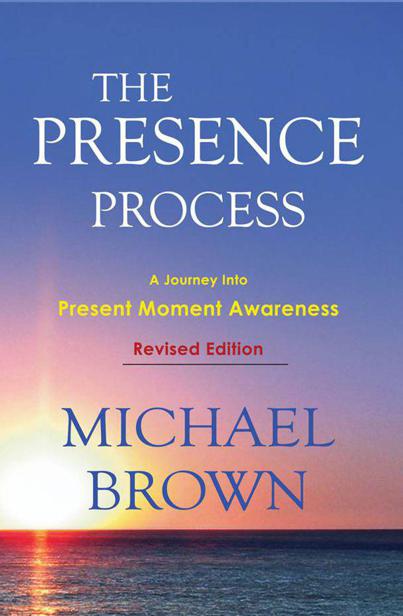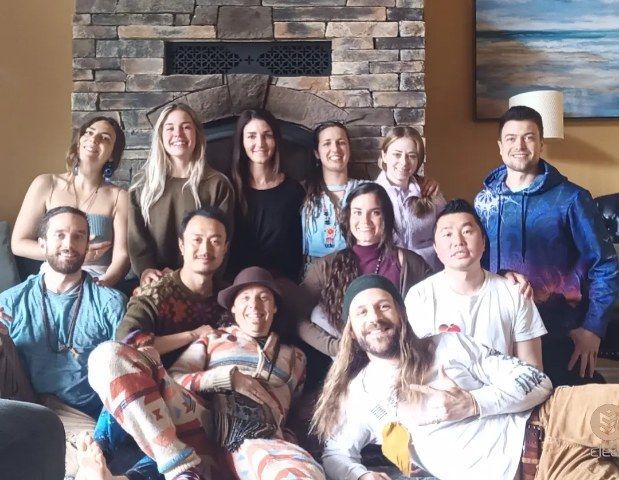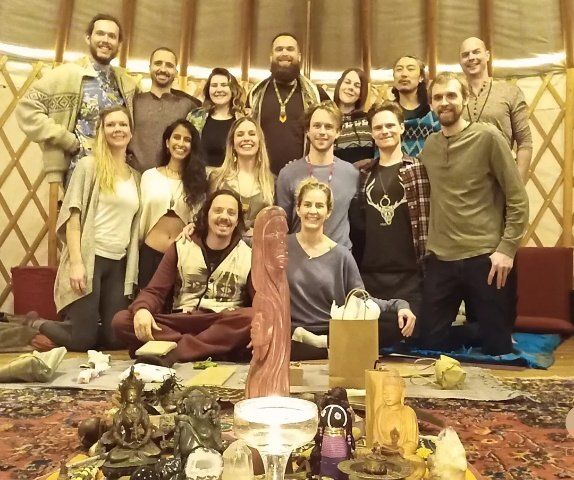My 10 Week Journey - The Presence Process
My Deep Dive Into Presence and the Clarity It Brought

-10 MINUTE READ-
Have you heard of The Presence Process?
If not, read on... This is a very powerful healing journey. One of the most powerful I have ever delved into.
The Presence Process is a 10-week self-improvement journey, self-facilitated and guided by the book of the same name written by Michael Brown. It requires, among other things, complete sobriety plus doing breathwork everyday.
You might be skeptical already... How do you expect anyone to commit to such a deep long process simply by reading a book?
Brown founded The Presence Process and originally held retreats, the typical setting for such a practice. He became saddened seeing graduates from his early retreats start holding retreats of their own and making lots of money off it. He wanted to make it more accessible for people who had less time and money, who couldn't experience this powerful journey in a retreat setting. Thus, he decided to write the book.
The book is written in a thoroughly clever way such that, if you have a strong enough motivation to improve yourself, once you start reading you will be convinced to start the 10-week journey. And the journey does deliver results, and from there spreads by word of mouth.
I was introduced to The Presence Process in the course of my training to become a Breathwave facilitator. Breathwave is a modality of breathwork founded by Robin Clements. Completing The Process is a requirement for becoming a facilitator.
Essentials of The Presence Process
The Presence Process consists of four activities: complete sobriety - no alcohol, cigarettes, marijuana, psychedelics or other mind-altering substances; breathwork everyday - 15 minutes in the morning, 15 in the evening; conscious responses at any given present moment; and weekly readings.
The first week's conscious response was "This Moment Matters." So my typical day started with a 15 minute breathwork session almost as soon as I woke up. Then throughout my day filled with work, other tasks and typical distractions, whenever I came back to the present, I thought to myself, "This Moment Matters." I would occasionally read some of, and eventually complete, Week One's designated readings. I would conclude the day with a 15 minute breathwork session.
The next week, Week Two's conscious response was "I Recognize My Reflections and Projections," and there were new readings. And so on and so forth. Every week's readings continually built upon and eventually rounded out my knowledge and application of The Process.
Doesn't seem as bad as it first sounds, right?
The central theme of The Process is to activate presence with the breath (creating healing).
It is embarrassingly simple. Almost all spiritual practices centre around presence and breathing. Brown simply provides a structure and practice accessible to laymen for activating more presence over a sustained 10-week period that creates enough transformation and ingrains new habits that will have lasting benefits after the journey is over.
Activating the breath creates present moment awareness. Through present moment awareness we slowly and surely pierce our conscious physical and mental processes and access our deeper subconscious emotional processes. With enough awareness of our subconscious emotional processes we can uncover and deprogram deeply rooted patterns of thought and behavior connected to our childhood experiences.
To Heal or Not to Heal?
Interestingly, Brown avoids using the word 'healing' explaining that he doesn't want to create the idea that we are inherently flawed and need fixing, nor does he want to create expectations around diving into the practices of The Process, which could ultimately get in the way.
This is why I put the parentheses '()' around creating healing. Without this, the quote still stands on its own: to activate presence with the breath.
By now, most of us intuitively understand the power of presence. Brown emphasizes this further by taking away any expectation around healing or improving yourself. By simply being present, you will manifest your reality, and everything you need will come to you. Whether your present experience is positive or negative doesn't matter, it's what you need to experience. If it's negative, this means you ultimately need to be with it in order to learn from it and overcome it. And that's where the healing happens.
My 10-Week Deep Dive
Doing breathwork everyday in the morning and evening was by far the most difficult part of the 10-week journey. Thankfully my schedule wasn't overly busy. Also thanks to having taken two Breathwave retreats this year, and sandwiching my second within the 10-week duration, my breath was already in higher activation. Still... it's a big commitment both in time and energy.
I got off to a slow start, but found my groove in Week 3, really feeling my breath activated. However, by Week 6, it felt less activated and remained this way the rest of the journey. Within this larger wave were smaller waves. The biggest lesson I learned is that the activation of my breath depended on how my day went. If something bad happened to me or I had a negative interaction, my breath would be less activated.
Overall, I feel happy with my commitment and results. By the end of most breathwork sessions I was able to activate subtle body sensations, which anchored me in the present and in my body. I missed less than 10 sessions total for various reasons, which I think isn't bad.
Being sober was overall not that difficult for me, as throughout a typical day I don't intoxicate myself much, not even with coffee. However, it was difficult at times to know that an intoxicant was never available, not even the smallest amount, to take a little edge off. If my mood was off or something was bothering me, I had to sit with it and be present with it.
This is precisely why sobriety and breathwork are so important, so we don't dissociate and run away from difficult emotions. Instead we face these emotions with our unconditional attention. I've done lots of healing work in my life and am in a pretty good place. I can imagine anyone carrying lots of trauma to struggle through this process knowing intoxicants were unavailable.
My ability to make conscious responses started off great, but over the last half of the journey I recalled them less and less, a result of waning commitment over such a long duration. But at least they never stopped.
Finally, the readings were fairly minimal and easy to keep up with. I resonated strongly with The Process and its theories as they aligned with my own cosmology, so I enjoyed reading and integrating his theories. For example, one central value Brown and I both share is integration. I believe this is the most underrated and important aspect of our moment-to-moment experience, and is key to overcoming uncomfortable emotions.
The philosophy of The Process reinforced and added to other philosophies I have dived into such as vipassana, Stan Grof's LSD Psychotherapy, Breathwave, and Internal Family Systems. These emphasize and activate the innate healing power within the Self, and that our present moment experience is shaped by unconscious material from the past, mostly traumas from childhood, that can be accessed in order to be overcome.
Essential Theories of The Presence Process
Here is some more theory to expand on the simplified explanation I gave earlier consisting of mostly quotes from the book itself. I copied and pasted notes while reading from an e-book to create a Coles Notes version of The Presence Process book which is available in this Dropbox link.
Physical, Mental, Emotional
Our present moment experience consists of physical and mental perceptions. These perceptions are based on emotional charges, which were imprinted on us from childhood experiences.
Reflections & Projections
Whenever anything happens that upsets us emotionally, whether it appears as an event or as another person’s behavior, we are experiencing a reflection of our past. Whenever we react physically, mentally, and emotionally to such an experience, we are projecting as a consequence of this reflection.
The core emotional experiences of the past that have an impact on our current experience are by their nature uncomfortable. The first consequence of charged emotion is drama. Drama is reactive projection – whether physical, mental, or emotional – which we use to gain the attention from others.
Sedation & Control
The second consequence of charged emotion is a behavior called “self-medication.” It manifests as sedation and control. Quitting self-medicating behaviors without integrating the associated emotional charge is ineffectual and accomplishes nothing.
Reaction vs. Response
A reaction is unconscious behavior as a result of physical, mental and emotional reflections & projections from our unintegrated emotional past. A response is a conscious choice to distance ourselves from engaging with the “messengers” and instead redirect our focus toward accessing “the messages” they bring.
The Presence Process invites us to respond to our experiences of pain and discomfort by listening to them instead of running from or attacking them. Our choice to respond instead of react gradually neutralizes our unconscious automatic impulse to react.
Cause and Effect
We realize that our unintegrated childhood emotions are the cause we normally can’t perceive of the physical and mental circumstances unfolding as the quality of our adult experience. We don’t impact causality by fiddling with effects.
Present Moment Awareness
Our breath is both an efficient and readily accessible tool for anchoring our attention in the present. In present moment awareness, there are no good or bad emotions. Any discomfort experienced from consciously connected breathing is the consequence of unintegrated past trauma surfacing into our awareness for integration.
The Messenger
Throughout The Presence Process, we call the triggering event that upsets us “the messenger.” We respond instead of reacting to the message by taking our attention off the messenger (the physical event or person’s behavior that is triggering us), stepping away from the story that urges us into reaction (in other words, detaching from the mental event), and placing our attention on how we are feeling as a consequence of the triggered upset (the emotional event).
Integration
The use of reflections (messengers) is the only way to “see” our deeply suppressed past in a way that empowers us to integrate it:
- DISMISS THE MESSENGER. The first step is to acknowledge that the person or event setting us up has nothing to do with what’s happening. They are “the messenger"
- GET THE MESSAGE. Through wielding felt-perception, encounter the underlying energetic resonance of the emotional reaction
- FEEL UNCONDITIONALLY. Instead of externalizing our discomfort by resorting to blame, we trade projection for integration, which we accomplish through unconditional containment
One of the biggest insights we may receive at this point is that it isn’t our adult experience that requires integration, but the unintegrated aspects of our childhood.
Healing
When charged emotion is sufficiently integrated, there’s no longer a foundation for addiction and affliction.
Only when we discover how to nurture ourselves with our own unconditional attention do we develop the capacity for attending to others unconditionally in an authentic way. Only when we are able to be this way with the felt-aspect of our experience are we able to be this way with others and the experiences they are required to go through.
Get Started!
All of the spiritual practices and modern gurus preach presence as the key to improving your life, and ultimately achieving sustained happiness. The Presence Process is probably the deepest dive into activating presence, without having to go to a short retreat. I wholeheartedly advocate for you to try it out. I also completed it together with two colleagues from my Breathwave retreats, checking in with each other every few weeks. I highly recommend finding someone else to do it with, as it increases engagement and accountability.
If not, I highly encourage you to receive breathwork. This is in my opinion the most powerful facilitated therapy available, because it activates our inner healer using our most primal and innate tool - our breath. I wrote several blogs about my Breathwave experience, starting here.
I am extremely thankful to have completed The Presence Process. Forcing myself to be present for so long was a challenge, but one that will have long-term benefits, whether you want to call it healing or not. I feel more in my body, able to sit with my discomfort so that I don't bottle it up, and eventually project it onto other people.
I'm sure more benefits will reveal themselves over time - I'm still integrating my experience.










